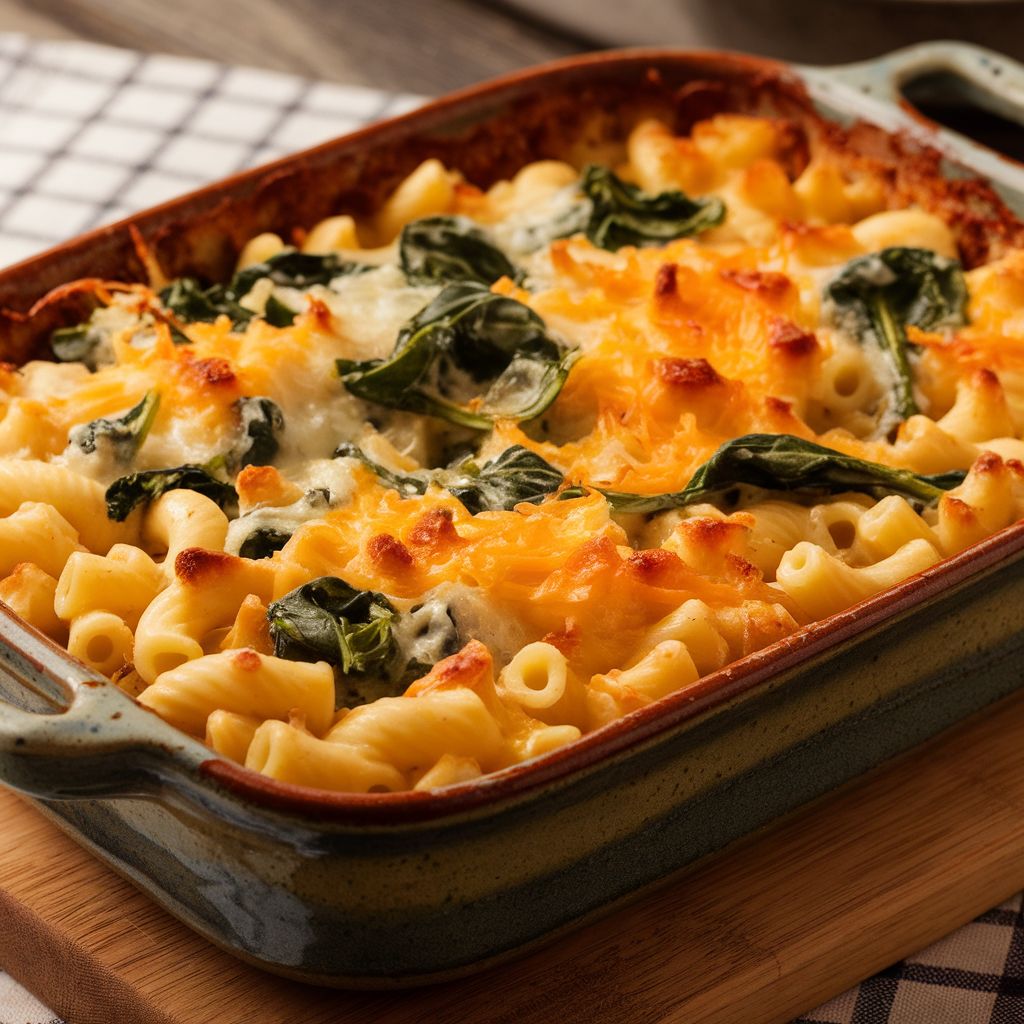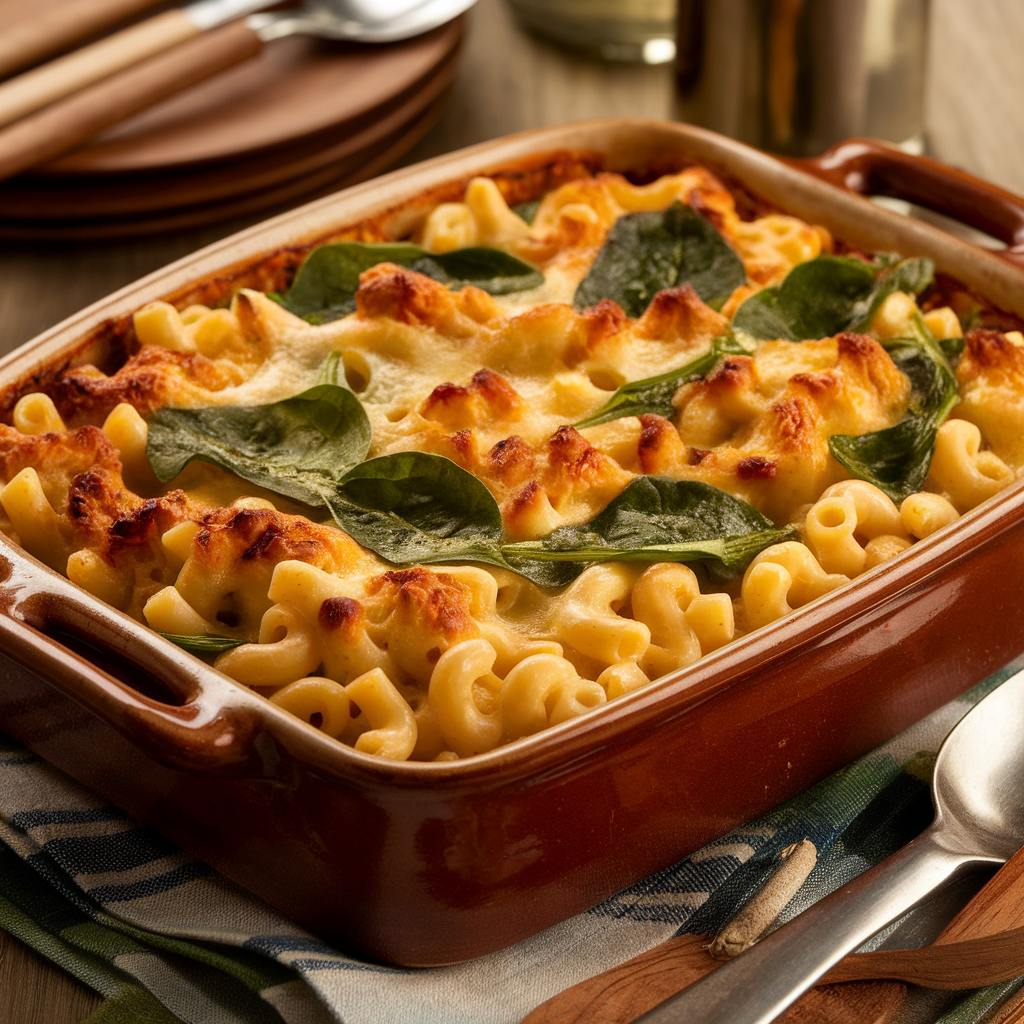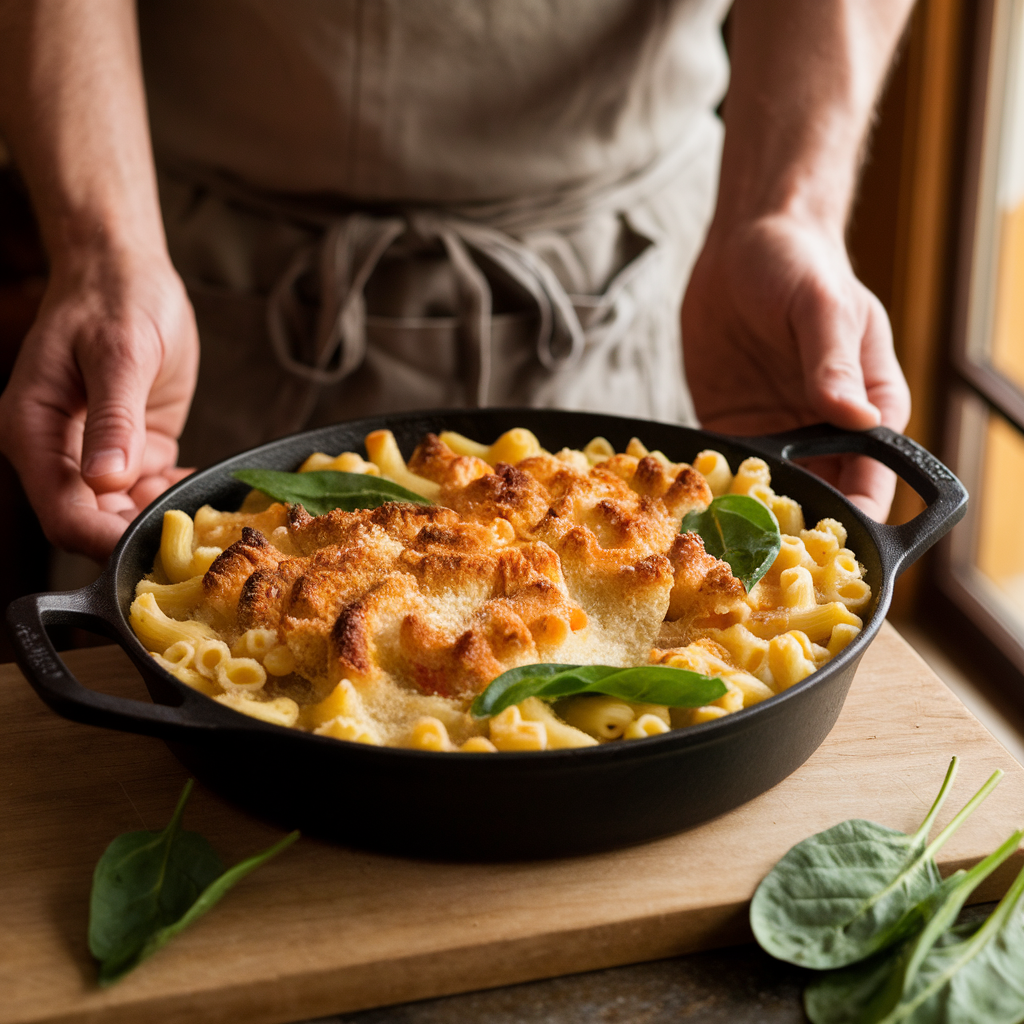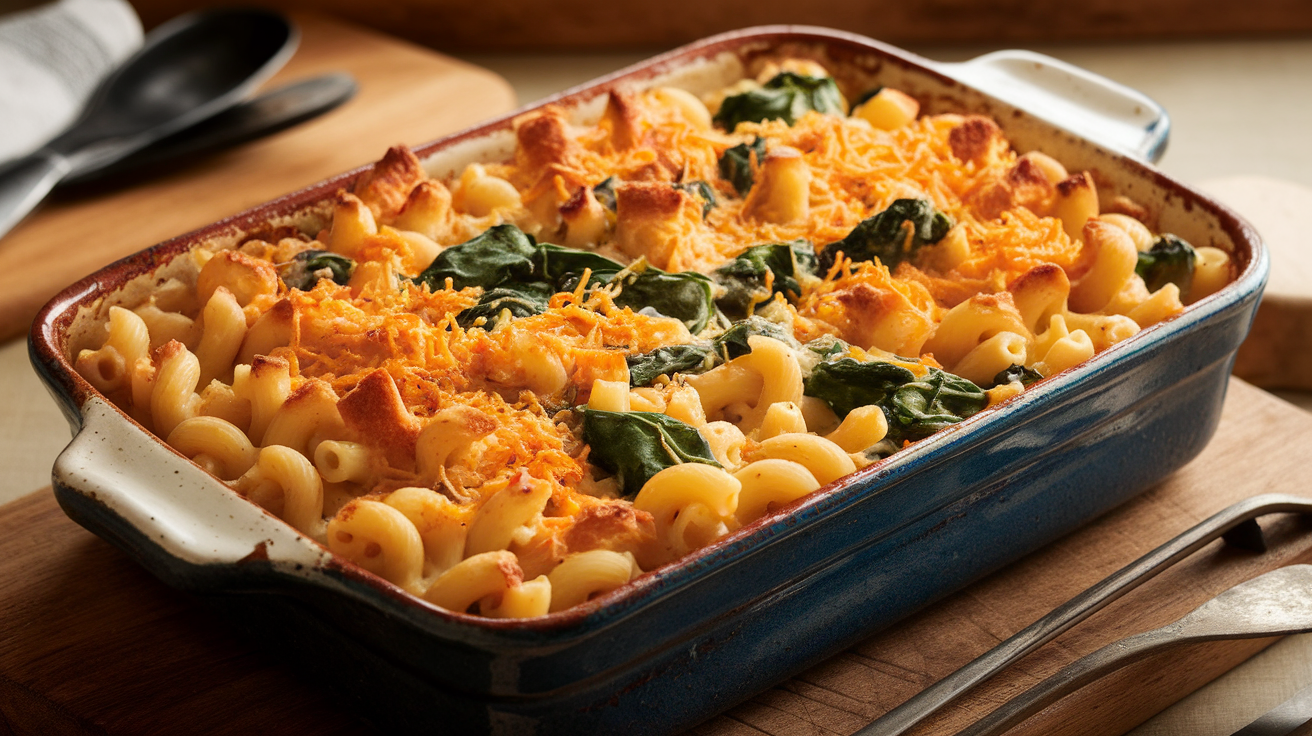When you think of comfort food, one dish that instantly comes to mind is the classic baked macaroni and cheese. It’s creamy, cheesy, and downright satisfying. But what if you could take this beloved comfort food and make it even better — more nutritious, flavorful, and visually appealing? Enter the old fashioned baked macaroni and cheese with spinach: a deliciously creamy, cheesy pasta casserole infused with fresh spinach for added health benefits and a vibrant color boost.
This recipe offers the best of both worlds — the rich indulgence of traditional mac and cheese casserole with the fresh, wholesome taste of spinach. It’s the perfect way to incorporate greens into your family’s diet while still serving up a crowd-pleasing dish that everyone will love.
What Makes This Recipe Special?
Mac and cheese with spinach stands out because it’s not just a cheesy pasta recipe — it’s a complete meal. Spinach adds a subtle earthy flavor and an extra nutritional punch without overwhelming the dish. The creaminess of the cheese sauce combined with tender pasta and sautéed spinach creates a comforting yet balanced casserole perfect for weeknights, potlucks, or holiday dinners.
Adding spinach to the traditional macaroni and cheese recipe transforms it into a bright, colorful spinach noodle casserole that looks as good as it tastes. Plus, spinach pairs wonderfully with cheddar and Parmesan cheese, creating layers of flavor that are both complex and familiar.
Key Ingredients and Their Roles
Let’s break down the essential ingredients that bring this casserole to life:
- Macaroni Pasta: The classic pasta shape for macaroni and cheese. Its tube shape holds the cheese sauce perfectly.
- Fresh Spinach: Adds a fresh vegetable element. Rich in vitamins A, C, K, iron, and fiber, spinach enhances the nutritional profile.
- Cheese Homemade Blend: Combining sharp cheddar, mozzarella, and Parmesan creates a rich, gooey, and flavorful cheese sauce.
- Butter and Flour (Roux): Essential for thickening the sauce and creating the creamy base.
- Milk: Whole milk or 2% milk provides the creaminess for the sauce.
- Seasonings: Garlic powder, onion powder, salt, pepper, and optional mustard powder balance and deepen the flavor.
- Breadcrumbs: Create a crunchy topping that contrasts beautifully with the creamy pasta beneath.
- Nutmeg (Optional): Adds warmth and subtle complexity to the cheese sauce.

Health Benefits of Adding Spinach to Mac and Cheese
Spinach is a nutritional powerhouse. Just one cup of cooked spinach contains:
- Over 100% of your daily vitamin K needs, essential for bone health.
- Significant amounts of vitamin A and C, supporting immune function and skin health.
- Iron, important for oxygen transport in the blood.
- Folate, which supports DNA synthesis and repair.
- Antioxidants such as lutein and zeaxanthin that promote eye health.
By incorporating spinach into your mac and cheese casserole, you’re boosting the meal’s health quotient significantly without sacrificing taste or comfort. It’s a subtle but impactful way to make a classic dish more wholesome.
Step-By-Step Recipe Instructions for Spinach Mac and Cheese
Etape 1: faire Cuire les Pâtes
Bring a large pot of salted water to a boil. Add 12 ounces of elbow macaroni and cook until just al dente — typically 7-8 minutes. Overcooked pasta will become mushy after baking. Drain and set aside.
Step 2: Wilt the Spinach
In a large skillet, melt 1 tablespoon of butter over medium heat. Add 3 cups of fresh spinach and sauté for 2-3 minutes until wilted and bright green. Remove from heat and drain any excess liquid using a fine mesh sieve or by pressing spinach with paper towels.
Step 3: Prepare the Cheese Sauce (Béchamel Base)
- In a medium saucepan, melt 3 tablespoons of butter over medium heat.
- Whisk in 4 tablespoons of all-purpose flour and cook, whisking constantly, for 1-2 minutes to cook out the raw flour taste. This creates your roux.
- Slowly pour in 3 cups of milk, whisking continuously to prevent lumps.
- Continue cooking until the sauce thickens enough to coat the back of a spoon — about 5-7 minutes.
- Remove from heat and stir in:
- 2 teaspoons garlic powder
- 1 cuillère à café de poudre d'oignon
- ½ teaspoon salt (adjust to taste)
- ¼ teaspoon black pepper
- ½ teaspoon mustard powder or 1 tablespoon Dijon mustard (optional)
- A pinch of freshly grated nutmeg for warmth (optional)
- Stir in 2 cups shredded sharp cheddar cheese, 1 cup shredded mozzarella cheese, and ½ cup grated Parmesan cheese until melted and smooth.
Step 4: Combine Pasta, Spinach, and Cheese Sauce
In a large bowl, gently fold together the cooked pasta, sautéed spinach, and cheese sauce until the pasta is evenly coated.
Step 5: Assemble the Casserole
- Butter a 9×13 inch baking dish.
- Pour the pasta mixture into the dish and spread evenly.
- Top with 1 cup of breadcrumbs (panko or regular) mixed with a tablespoon of melted butter for extra crispness.
- Optionally, sprinkle a little more Parmesan or cheddar cheese on top for a cheesier crust.
Step 6: Bake
Preheat your oven to 350°F (175°C). Bake the casserole uncovered for 25-30 minutes until the top is golden brown and bubbly.
Step 7: Serve and Enjoy
Allow the casserole to cool for 5 minutes before serving. This rest time helps the sauce thicken and sets the casserole for cleaner slices.

Pro Tips to Elevate Your Spinach Mac and Cheese Casserole
- Use freshly grated cheese rather than pre-shredded for smoother melting and better flavor.
- Don’t skip the roux — it’s essential for a velvety, creamy cheese sauce that clings perfectly to pasta.
- Squeeze out spinach moisture completely to avoid watery casserole.
- Experiment with cheese types: Add Gruyère, Fontina, or Gouda for deeper flavor.
- Add herbs: Fresh thyme, parsley, or chives can brighten the dish.
- Top with crunchy extras: Crushed Ritz crackers, panko with Parmesan, or even crispy fried onions add texture.
Variations and Add-Ins for This Classic Recipe
Protein Boost
Add cooked and shredded rotisserie chicken, diced ham, or crumbled bacon to turn this into a heartier pasta meal.
Different Greens
If you don’t have spinach, kale or Swiss chard are excellent substitutes. Just be sure to sauté and drain them well.
Spice It Up
Add a pinch of cayenne, smoked paprika, or chipotle powder to the cheese sauce for a spicy kick.
Vegan or Dairy-Free Version
Use plant-based milk (such as oat or almond milk) and vegan cheese alternatives for a dairy-free mac and cheese casserole.
Serving Suggestions: Pairing Your Spinach Noodle Casserole
This rich, cheesy pasta meal pairs well with light sides to balance the richness:
- Crisp green salad with lemon vinaigrette
- Roasted vegetables like Brussels sprouts or asparagus
- Fresh fruit salad for a sweet contrast
Storing and Reheating Your Baked Macaroni and Cheese
Les restes should be stored in an airtight container in the fridge and consumed within 3-4 days. To reheat, cover the casserole with foil and warm in the oven at 350°F until heated through to retain the crispy topping. Avoid microwaving if possible, as it tends to make the pasta soggy.
For longer storage, this dish freezes well. Cool completely, cover tightly with foil and plastic wrap, then freeze for up to 2 months. Thaw overnight in the fridge and bake as usual.

Why Make Homemade Cheese Sauce Instead of Using Boxed Mix?
Many convenience mac and cheese casserole recipes rely on boxed cheese powders or pre-packaged sauces, but homemade cheese sauce is far superior in taste and texture. When you make your own cheese sauce:
- You control the ingredients, avoiding artificial colors and preservatives.
- The flavor is richer, creamier, and fresher.
- You can customize cheeses and seasoning to your preference.
- The sauce clings better to pasta, preventing dryness or clumping.
The History of Macaroni and Cheese and How Spinach Became a Modern Twist
Macaroni and cheese traces its roots back to medieval Europe, where pasta and cheese dishes were popular in Italy and France. The classic American baked version gained fame in the 18th century, becoming a staple comfort food.
In recent decades, chefs and home cooks have innovated by adding vegetables like spinach to balance richness with nutrition and color. This evolution reflects a broader trend of incorporating greens into traditionally indulgent dishes for a healthier spin.
How to Customize Your Spinach Mac and Cheese for Different Dietary Needs
- Sans Gluten: Use gluten-free pasta and gluten-free flour or cornstarch for the roux.
- Low Carb: Substitute traditional pasta with spiralized zucchini noodles (zoodles) or shirataki noodles, though baking time and texture will vary.
- Keto: Use low-carb pasta alternatives and full-fat cheese and cream.
Foire Aux Questions (Faq)
Can I use frozen spinach?
Yes! Just thaw and squeeze out excess moisture thoroughly before adding it to the cheese sauce. Fresh spinach is preferred for best texture and flavor.
What type of cheese is best for mac and cheese?
Sharp cheddar is classic for its tang and meltability. Adding mozzarella increases creaminess, while Parmesan adds nuttiness. Feel free to experiment!
Can I prepare this casserole ahead of time?
Absolutely. Assemble the casserole, cover tightly, and refrigerate for up to 24 hours before baking. Add extra baking time if baking from chilled.
How do I prevent the casserole from getting watery?
Make sure to drain pasta well, sauté and drain spinach completely, and cook the sauce to proper thickness before mixing.
Final Words: Why This Recipe is a Must-Try for Every Pasta Lover
L' old fashioned baked macaroni and cheese with spinach recipe perfectly balances tradition and innovation. It delivers creamy, cheesy comfort with a nutritious twist. This dish is approachable, adaptable, and always a crowd-pleaser — ideal for busy families, entertaining guests, or anytime you crave a rich pasta meal with a vegetable boost.
By mastering this recipe, you add a versatile and wholesome casserole to your cooking repertoire, offering delicious meals that satisfy cravings and nourish the body.
So next time you crave cheesy pasta recipes, try this spinach mac and cheese casserole — you’ll never look back!


